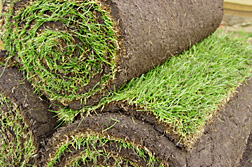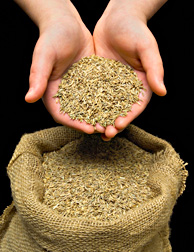Creating a Lawn from Turf or Seed
Turf Lawn
If you decide to create your lawn using turf, then the quality of turf you buy is all-important so you need to choose your supplier carefully.
If you have the time, it is worth watching for other people laying turf in your area and to see how well it does. There is no real substitute for personal experience and recommendation.
The main points to watch for include:
- Can the dealer supply turf with grasses that are appropriate for your intended use?
- Are you able to see the turf growing so that you can check it looks healthy and free from weeds?
- Is the dealer able to cut and transport the turf at a time that is suitable for you since it rapidly deteriorates if left for more than a day between cutting and relaying?
Given the time restriction, it is essential to have the ground fully prepared before the turf is delivered so that it can be laid more or less straight away.
The turf is cut into narrow stripes, which are then rolled. When it is delivered it is better if you stack the rolls out of direct sunlight so there is less chance of them drying out even during the work of laying the lawn.
Laying the Turf
For best results, it is worth taking the trouble to lay the first stripes of turf in a straight line along one edge of the lawn. If there isn't a hard edge to work to, then a length of string stretched between two pegs can help to keep the edge straight. It is advisable to work from scaffolding boards to spread your weight and minimise damage to the final surface.
Once you are satisfied with the first stripe, you should lay subsequent stripes ensuring that the edges are butted up as close as possible. This is important since the turf is likely to shrink slightly if it dries out and you want to avoid any gaps appearing.

Lay the rolls of turf in the same pattern as a bricklayer lays bricks so that the joins are staggered. This results in a stronger finish and the joins will disappear more quickly.
As each roll of turf is layed, it is important that it comes into close contact with the underlying soil so that the grass roots can penetrate easily. To ensure there are no gaps between the turf and the soil, tamp down the turf with the end of a rake. Alternatively you can easily make a tamping tool specifically for the job from a square piece of wood (about 8in by 8in though the exact dimensions are not critical) fastened to the end of a broom handle.
Don't overdo the tamping. Remember it is only to ensure that the turf is in close contact with the soil. You are not attempting to flatten the turf.
Once all the turf has been layed, it is important to keep it moist. Rain is God's natural way of achieving this but in the absence of rain, you need to water it yourself. The rule of thumb is not to neglect and not to over water. In other words, little and often.
If everything is done correctly, the grass should continue to grow naturally so that you can usually start cutting the lawn about a week after it has been layed.
Seed Lawn
You are more limited in when you can grow a lawn from seed. In theory, it can be done anytime from spring to early autumn - in other words throughout the main growing season. However, you also need to take account of the prevailing weather conditions. If, for example, your summer months tend to be hot and dry, you are best to avoid them or you will have a lot of irrigation to do in order to establish the lawn.

Select your seed mixture according to the type of lawn you want. More specialised strains of grass seed are being developed all the time so that you are able to buy mixtures that are suited for ornamental lawns, hard wearing lawns, dry areas, damp areas and shaded areas such as under trees.
Buying grass seed is much cheaper than buying turf so don't go for the cheapest you can find. Since you want the lawn to last and look good for many years, it is worth buying from a reputable supplier and paying a little more for it if necessary.
Sowing the Seed
You should buy sufficient seed to cover the whole area of lawn at one go. The packet will advise you the area it will cover and the amount needed for each square yard or metre.
For the most uniform sowing, it is best to mark out the area with wooden pegs and string into standard sized squares. It is then relatively easy to take the recommended amount of seed for each square and scatter it evenly by hand.
Once all the area has been seeded, give it a light raking with a springbok rake. If you have one available, a light roller can be useful to ensure the seed is in good contact with the soil.
Finally water the whole lawn using a fine spray so as to provide irrigation without disturbing the surface. It is important to maintain irrigation throughout the period while the seeds germinate and establish themselves. This might mean a light watering up to twice a day for the first two weeks.
Early Care
Once the seed has germinated, don't be afraid to walk on it though treat it with some respect. The slight damage caused by gentle use is actually beneficial because it encourages the young plants to send out additional shoots which help to thicken the lawn.
Don't think about mowing the lawn until it is a least one and half to two inches tall. At that stage you can give it a light cut but only removing the top third. Also make sure the mower is in good condition and sharp so that there is little likelihood of snatching the young plants out of the soil.
Continue this cutting regime until the lawn is really well established when you can gradually lower the height to half an inch or so.
Also watch for any weeds that have introduced themselves into the lawn. If you have been careful in your preparation, this should not be a huge problem and you can probably keep on top of them with careful hand weeding.
Read more about Lawns |
Read more about Plants |
